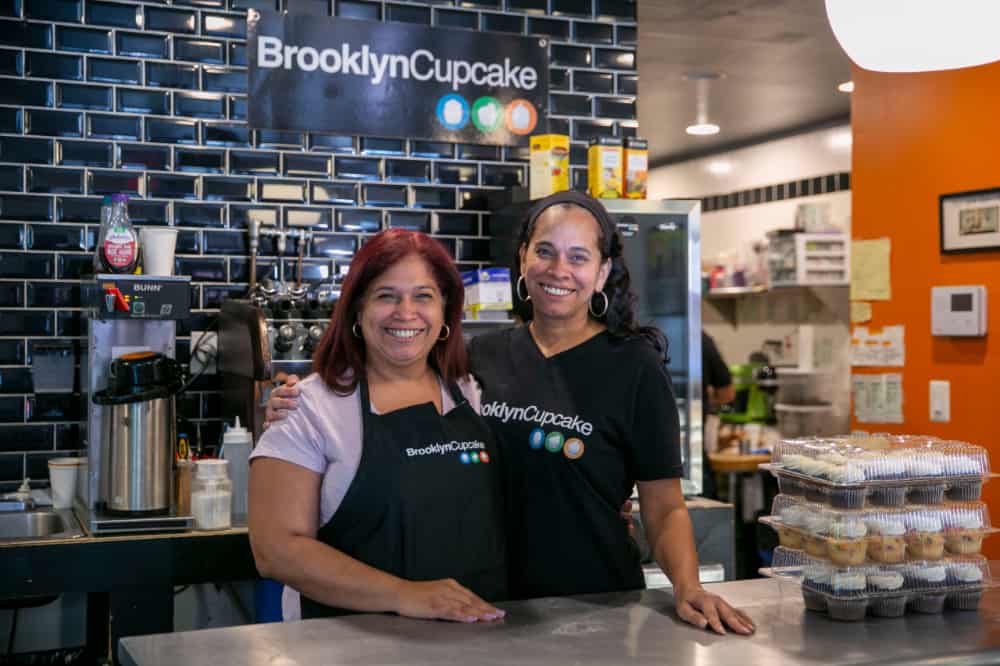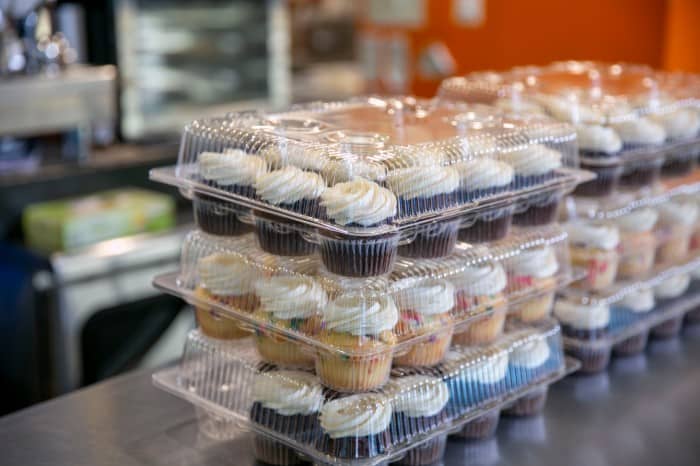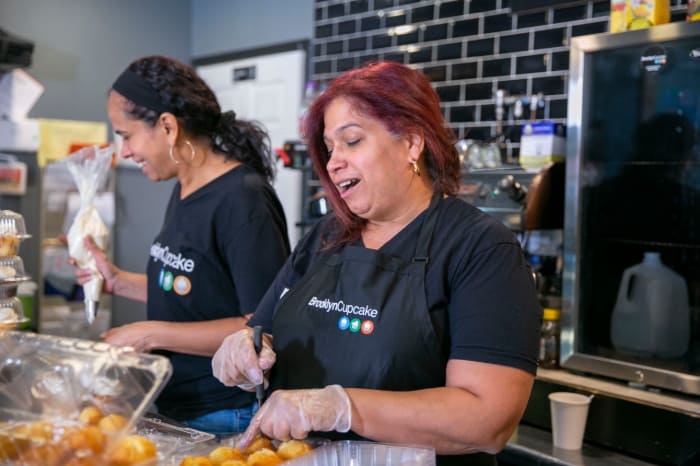How Brooklyn Cupcake Grew from Neighborhood Shop to Nationwide Success

Many business owners take the leap into entrepreneurship more out of necessity than to pursue their passion. Sisters Carmen Rodriguez and Gina Madera launched their business Brooklyn Cupcake during the Great Recession after Carmen found herself unemployed. Nine years later, business is booming, and the sisters have made the family-owned business a multi-generational affair by bringing their kids into the fold to manage all the growth.
Read on to learn more about how they bootstrapped Brooklyn Cupcake with help from their family and their community.
How they started Brooklyn Cupcake
Like many other Americans, Carmen found herself looking for her next job during the last recession. She had always loved baking and was renowned among her friends and family for her tasty desserts. As she says, “Finding a job was kind of difficult. Baking, which was my hobby, became my therapy. So sitting at home, the phone started ringing, little by little. At first I got orders for baby showers, maybe small intimate weddings. But the big break came in the month of December when we got a phone call from a church that ordered 1,500 cupcakes the first time around, then two weeks later they ordered another 1,500.”
At that point, Carmen realized she had found her next gig. Realizing she’d need more manpower to get the business off the ground, she decided to rope in her sister Gina to be her co-founder.
They came up with the idea to make cupcakes inspired by their own diverse Puerto Rican, Italian and American heritage. Carmen explains: “Brooklyn Cupcake is unlike any other cupcake place. I know everyone says this, but it’s the truth. When we started this, the competitors stood within a certain, I say, safe house: red velvet, Oreo, flavors that were very common to people. Our background is Puerto Rican and Italian, so we went back to our roots and created flavors like tres leches, coquito, tiramisu, flan – things that touched home. And that’s what I think sets us apart.”
Getting the business off the ground
Like most other small business owners, Gina and Carmen struggled to get the funds together to start their business. Also like a lot of small business owners, they ended up taking funds from a family member. As Gina says:
“One day we start trying to figure out what it would take to get a place, and equipment, and so on. My mom is in the house with us, and comes in and she says, ‘I hear you two talking. Are you serious?’ It’s like, ‘Of course we’re serious. We’re going to figure out how to make this work for us.’ So she turns around and she says, ‘I don’t have much. I live with you. I’m going to give you my 401(k) so that you can make it. I might end up with nothing. The only thing I ask is at the end you bury me.’ So I said, ‘Mom, I’m going to take it and make it work.'”
“She gave us everything she had. We knew we had to make it work, and here it is. Eight years later, we’re still floating. A lot of people know our name, and she’s very proud.”
Their mother’s retirement savings helped them get a store, equipment and some initial supplies. Their storefront was initially a bit of a “diamond in the rough.” As Carmen says, “It had been sitting abandoned for 20 years. It was a slow process, though, because it was one of the best places we had seen, though it didn’t look great in the beginning. There were no floors, no walls, no nothing like that. But I come from a retail background, so I know that you’ve got to shop your competition, I went to the baker in the neighborhood who was just a bit up the ways, and her place was smaller. So I thought we had arrived with a 500 square foot place, choosing this place.”
To get the storefront ready for business took about a year. Luckily, as longstanding members of the local community many other local businesses offered support to help them get up and running. Carmen says, “It took us about a year to get it together. A lot of local architects, plumbers and electricians came to our aid when they heard that our family wanted to do this. We have long ties in the community- we grew up not too far from here and my dad is a contractor. So everybody knew that we were bootstrapping, and everybody gave us services almost at cost, which was a blessing.”
Being a part of the local community
Considering the amount of support their community gave them to get the business started, it’s no surprise that Carmen and Gina try to support their local community in return. Brooklyn Cupcake tries as much as possible to source supplies locally. As Carmen says: “We attend networking meetings to get to know other local business owners. Then from there we try to see how it is that we can all help each other out. Somebody may sell boxes: we do shipping. We’ve had two people in our area that provide us with our flour, our sugar, things like that. We try to give back to the community and buy back locally.”
They’ve also found that their customers and employees have become an important part of their lives: “customer service, that’s my favorite part of the business. That’s the only thing that can make every day a bit different. When we started this business, my sister and I, we got into it thinking that we were going to be rich, because we had this great concept. That changed. As we got to know our customers and community, it touched our heart. For example, we’ve employed mothers who have had special needs children that want to get back into the working community but needed a flexible schedule, which we were able to offer them. We have had some incredible stories.”
Their love for their community is definitely mutual – Brooklyn Cupcake is decked out in art given to them by local fans. Carmen says, “Each and every piece that you see up on the walls was given to us by people who have found some sort of love or fascination with us, are excited to share it with us. All of them are unbelievable.”
Diversifying their business revenue over the years

“We put a lot of love into each and every cupcake.”– Carmen Rodriguez
Carmen and Gina quickly learned that they would need to expand beyond cupcakes to make their business successful. Carmen says: “Being in business nine years, we learned that man cannot survive off of cupcake alone. It was important for us to roll out a few other things. We gave it some thought and it thought we might try selling these flans that we make at home that are similar to a crème brûlée.”
“That turned out to be too much of a process, so I came up with the idea of baking these huge flans but then converting them into a mousse… that’s the Italian part. And that’s how we started doing a flan mousse with our cupcakes mixed in, topped with a homemade caramel sauce. Then from there we diverted to making banana pudding, and that’s been a huge success for us.”
Then they opted to get into special order desserts: “We now offer cakes made from the same great recipe as our cupcakes. This would be the first year that we’ve done that, and it has been wonderful. We thought we didn’t have room for it, but we made room. Because you know what happens? People start with you as a customer. First, they come to you and they’re just a customer, then, ‘You know what? I’m getting married. Guess what? I’m having a baby.’ Now, we’re like part of families because we make the cakes for all these special events.”
Managing new tech in the restaurant industry
New technology platforms like Seamless, Grubhub, or Uber Eats has also helped them expand their business, though sometimes they can be tough to manage. Carmen explains: “We have probably about five different delivery platforms and each one of them comes with a tablet and each one of them will give you an alert: “Bing! An order has come in.” And you’ve got to stop what you’re doing, pay attention, because usually a driver will be outside of your door in just a few minutes to pick it up.”
“That can trip us up sometimes. On a normal day not so bad, but on a holiday week like Halloween, Thanksgiving, Christmas, or whatever, it starts to get a little crazy. So yeah, it can be challenging at times to follow all those delivery platforms.”
However, these new technologies have also given them the opportunity to sell nationwide: “Nowadays, you can find Brooklyn Cupcake available on Goldbelly, which is a nationwide shipping platform. If you’re from Brooklyn but now living in California, we can get the cupcakes to you.”
Hiring and Retaining Employees
Another challenge facing many other food service businesses is finding and retaining successful employees. Brooklyn Cupcake is no different. Carmen says, “I think our biggest challenge is employee retention and being able to keep up with the Joneses. Big businesses have a set of government rules that they have to follow, and sometimes we get exempt from that. For instance, we were originally exempt from the $15 per hour minimum wage. This year, however, we’re now required to raise our wages too.”
“This a serious challenge for us. We love our people and we think they’re worth a million dollars, right? But now we need to rethink our wages for existing and new employees to make sure we reward them appropriately.”
Their solution has been to offer what most of their employees want, which is flexibility. They’ll give their employees more control over their work schedules and the ability to take extended vacations. Larger companies may be able to pay a higher wage, but they often won’t give their workers that much flexibility.
Financing challenges
Beyond hiring and managing new technology however, Carmen and Gina found that managing their finances is often one of their biggest challenges. Carmen says, “having cash flow challenges can put somebody in a position of almost wanting to have a mental breakdown. That’s the easiest way for me to put it. When it gets to that point, you just start sweating. You don’t sleep at night.”
They discovered getting the financing they needed as a small business was much tougher than people think.
When they looked into getting a loan from their bank, they found that “the amount of paperwork that you have to do is ridiculous. New York City offers these agencies that can help guide you through things, and you’ll go to them for assistance, but they’ll ask for pages and pages of documents, and before you know it the process takes 30 days just to get the paperwork together, then you have to submit, and then you have to wait. It’s extremely challenging.”
After all that, they learned they couldn’t even get a line of credit from their bank.
They found that working with OnDeck was much simpler: “now it’s been three years that I’ve been with OnDeck, and unlike the banks I hear from my rep every six months or so checking in to see how we’re doing. That doesn’t really happen anywhere else.”
“The initial process with OnDeck was so easy too. I submitted all of my paperwork. That probably took only a day to gather. They don’t ask for a huge list of documents. And I’m going to tell you that I probably had an answer within the next day, and the funds were in my account the next day after that. That’s maybe three or four days for the whole process.”
They put their funds towards both day-to-day business needs and expanding. They’ve invested in new creative marketing opportunities, like pop-up shops, and acquired new equipment. As they say, “When we were able to implement those new initiatives we were able to acquire more accounts, more sales. It’s always the bottom line. You always try to take in more to get more money.”
Running a family-owned business

“My sister makes a better cupcake. I make a better-looking cupcake. She’s got all the flavors. She’s got everything. But I will dress them all.” – Gina Madera
In addition to the common challenges of running a small business, Carmen and Gina have also overcome the unique challenge of running a family-owned business. Carmen says, “Running a family-owned business is not the easiest, that’s for sure, but it just depends really on the foundation. My sister and I, prior to this, we’ve worked together in different corporations, different things. We have different strengths. I’ve always done sales, she’s always done financing.”
Gina feels the same way: “Working with your sister is extremely easy-hard. If you know your place and you know what strengths you come into the business with, it’s easy. It’s hard because it’s a thin line. You don’t where to separate family from business. She’s been my big sister for a very long time, so I know how to listen. She’s always told me what to do.”
It’s worked out so well that they eventually brought their husbands into the business, as well as their children: “we now also have our children working in the business. They are now grown adults. We started this when they were teenagers, so at first it was cool and hip to work with us, and then they were like, ‘We’re out of here.’ But guess what? They’re back today because they realize that nothing is better than being home.”
At the end of the day, the support they’ve found by working with their own family is invaluable: “today we are really in love with the fact that we are a family-owned business. I think that sometimes you don’t realize what you’re getting yourself into, but yesterday, which was a busy day for us, we had the rest of the family members here. We sing, we dance, we do a bit of crazy things, and at the end of the evening we hug and kiss each other and I don’t think that there could be anything better than that, honestly.”




